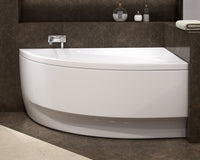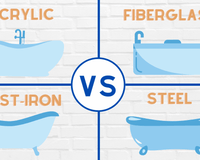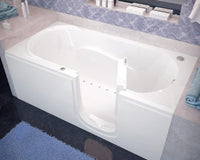Steam bath at home is noticeably a popular wellness trend these days. Before, a steam bath could only be enjoyed at a spa, gym or fitness center. Today, more and more people are turning their showers into home steam baths– for privacy, convenience, and limitless relaxation.
You may be wondering: is a steam bath right for you? Is it really possible for you to bring steam into your home?
We collated everything you need to know about steam bath at home– its benefits, risks and expert tips on how you can effectively enjoy it at home.
What is a steam bath at home?
A steam bath, in its most basic sense, is an enclosed, steam-filled space that is powered by a steam generator. People enjoy it for many reasons, but mostly for relaxation, cleansing and muscle recovery.
***Also read: 8 Best Steam Generators for Shower (2023 Review)
Heating the body with steam has long been practiced since, like, forever– way back in the ancient times of Greek and Roman civilization. Thanks to modern technology, steam bathing was made more accessible; just visit your go-to wellness centers or build a private steam sanctuary at your own residence.
What is the difference between a steam bath at home and a sauna?
The difference between a steam bath and a sauna is the type of heat used and the level of humidity inside the rooms. Sauna uses dry heat with very low humidity while steam rooms have higher level of humidity.
Sauna is a specially-built, wood-paneled room that uses dry heat (produced from either wood, gas, electric or infrared technology) to keep the room hot enough for the bather. It’s typically heated between 180°F and 195°F with very low humidity, thus the heat is relatively dry.
Steam rooms, on one hand, are heated between 100 and 120°F and have nearly 100 percent humidity. Technically, they’re not as hot as saunas, but you’ll feel hotter because of the high humidity.

Which is better?
In terms of health benefits, steam rooms and saunas basically have the same effect on the body, regardless of whether dry or moist heat is used.
This means you'll still get the same cardio benefits, along with reduced muscle pain and stiffness, and even a good night’s sleep (Read more about its tried-and-tested benefits below).
Their accessibility, your budget and the overall experience could be the more influential factors in deciding which one is better for you.
Do you like visiting outdoor saunas or do you prefer enjoying them alone at your home– any time of the day? Which is more practical for you: stop by these establishments at certain times in a month, or build your own and save money in the long run? It’s really a matter of personal preference.
Practical Tip
For a more budget-friendly or temporary option, you may turn your bathroom into a makeshift steam room by simply running a hot shower and then letting the room be filled with steam. However, the experience is not as complete and effective as when you use a steam generator.
What are the benefits of a steam shower or steam bath at home?

As mentioned earlier, body steaming at home has been practiced for centuries by many cultures, yet its scientifically-proven health benefits are still widely acknowledged in modern times. Here’s why:
1) Steam makes skin healthier.
Skin gurus would always advise “in order for your skincare products to be more effective, make sure to steam the skin before doing your routine” – and it’s true! Steam helps open your pores, so any dirt and debris buildup inside can easily be cleaned. When pores are open, your skin can also better absorb the nutrients you feed it.
While steam can’t technically make your pores smaller than their innate size (due to genetics), cleaning the pores with steam makes them appear smaller. Steam can also hydrate dry skin, making it softer and more supple. As a result, you have healthier and more glowing skin.
Before going to bed, try to take a quick steam bath with your favorite essential and organic oils. Steam heads have aromatherapy features so you can relax with pleasant fragrances as you steam. This will not only nourish your skin but will also give you a more restful slumber.
2) Steam relieves nasal and respiratory congestion.
Steam can similarly loosen the mucus and phlegm that causes nasal congestion and breathing troubles. This is especially helpful for children during allergy season or when they catch a cough or cold. Taking a steam bath is just like inhaling steam from a bowl– but better! You can clear up your nose and chest without the danger of scalding yourself.
For parents who have clumsy and impatient children, staying with them in your own home steam bath is a safer and more enjoyable way to relieve the congestion. More bonding time with them, and less stress for you!
“Steam may be invisible, but the effects are surely visible even to the most inner organs of our body”
3) Steam improves blood circulation.
Steam may be invisible, but the effects are surely visible even to the most inner organs of our body.
The heat from the steam can significantly improve blood circulation by dilating blood vessels. This way, the blood and oxygen can continuously flow throughout the body, allowing our organs to function properly.
Good blood circulation is key to maintaining optimal health. It can keep your heart healthy, your brain sharp, and it may even give your skin a natural flush.
4) Steam aids in muscle recovery.
Speaking of improved blood flow, moist heat from steam can also help relieve muscle pain and damage. Heat shifts blood from your core into your muscles, increasing blood flow in this body region.
How is that exactly helpful to our muscles? More blood flow to the muscles can help wash away waste products produced during workouts or any strenuous activity–which causes its damage. Hence, steaming can greatly aid muscle healing and recovery.
If you think this after-workout session can’t get more relaxing, try adding a music therapy feature that lets you play music of your choice while steaming. Many people find relief and healing in music. In fact, even the prominent scientists Aristotle and Plato had used and believed in this therapy method during their time.
5) Steam promotes better mental wellness.
Tension, stress, anxiety– these are the negative emotions we feel on a daily basis. If we don’t know how to lessen or manage them, these energies can exhaust us, and can negatively affect our everyday activities.
While steam is not a medical treatment or alternative solution to any health condition, many recent studies– together with actual experiences and testimonials–suggest how steam can effectively uplift our mood and positively affect our mental health.
The steam’s warmth doesn’t only feel physically good to the body, it is also ‘good’ for our mental wellness as it helps the body release endorphins or the ‘feel good’ hormones. Similarly, heat can decrease the body’s level of cortisol a.k.a the stress hormone. When endorphins are activated and cortisol level drops, you feel more relaxed, in control, and rejuvenated.
Aside from aromatherapy or music therapy, modern steam baths also have chromotherapy (popularly known as chromatherapy) features, or color therapy lights, which are good relaxing add ons to your steam bath.
Color therapists explain that each color has a unique wavelength and frequency, with different healing effects on people. Warm colors are typically used for stimulating effects (to boost mood and motivation), while cool colors are used for calming effects (for stress and anxiety relief). [Source: Very Well Mind]
Disclaimer: We can point out all the benefits that have been and are continuously enjoyed by steam bath users. Yet again, steam is neither a cure nor treatment for any health condition. It can only be a complementary therapy that adds to your healthcare. Anyone–healthy or not– should seek advice from a professional prior to taking steam baths.
What are the health risks of a steam bath?
As much as how beneficial steam is to our health, it’s not for everyone. There are some risks to it, depending on your health status and condition.
If not well-hydrated, one can experience dehydration or dizziness from the heat. Due to the extreme heat in steam rooms, there are certain people who are advised to avoid them [Source: Medical News Today]:
- Anyone with cardiovascular disease, or very low or high blood pressure
- Anyone with epilepsy
- Pregnant women
- People taking antibiotics
- Users of mind-altering drugs, such as stimulants, tranquilizers, or alcohol
Does this mean that people with health issues are strictly prohibited from using steam baths? The only person who can answer that, and the only one who should be advising you, is your doctor.
If you are allowed and healthy enough to take a steam bath, still exercise caution and observe safety measures at all times.
How can you safely enjoy a steam bath at home?

To maximize the enjoyment and benefits of a steam bath, it’s important to always practice safety and hygiene when using them:
1) Use in moderation.
Taking a steam bath every day should pose no health risks. But longer isn’t better in a steam room. Even for people who are generally healthy, the duration of one session should be kept at 20-30 minutes or shorter per day.
What’s the best time to steam and how frequently should you do it is purely up to you. Some people like to do it as a part of their morning routine in preparation for the day’s hustle. Others, particularly those who have sleep problems (1 in every 3 Americans are sleep-deprived), use it for relaxation in the evening to get their much-needed rest.
2) Monitor yourself while steaming.
One session may also be shorter than 30 mins, depending on how acclimated you are to heat. So, make sure to monitor yourself while steaming and regulate the temperature accordingly.
If you feel lightheaded or dehydrated after doing a physical activity like running or a full workout, it’s not really a good idea to spend a long time in the steam bath. But if you’re well-hydrated and feel fine, you can stay a bit longer.
3) Don’t go when you’re sick.
Don’t use a public steam room or even your own steam bath when you’re sick. Bacteria thrive best in warmth and moisture– which a steam bath is full of. If you have a bacterial infection, it can easily be passed on to other users in this environment. Use the steam bath again when the infection has totally cleared up.
4) Do not eat before steam.
Wait for one hour before taking a steam bath if you ate something heavy prior to the session. While steaming, there can be changes in your blood circulation. If you’re too bloated after eating, this can mess up your digestive system.
Likewise, refrain from drinking alcohol. The high heat of the steam room alone can be highly dehydrating, more so if you drink alcohol. Drink water instead.
How to take a steam bath? (Before, during and after)
Here are the proper steps to do before, during and after taking a steam bath:
Before a steam bath
- Drink lots of water to avoid dehydration. You'll be doing a lot of sweating while you steam bath. Plenty of water will keep you from dehydration.
- Take a shower. To make your steam bath more effective, your body has to be at its natural temperature. Showering with cold or hot water can help your body be in this state. A hot shower, though, is better in terms of opening and cleaning blocked pores that can prevent your body from efficiently secreting toxins. [Related article: Hot vs. Cold: 11 Surprising Health Benefits of Bathing]
- Dress lightly. For an effective steam bath, less is more– and this extends to everything on the skin. Rinse off any makeup or skin products and take off any accessories. Wear a light cotton towel, so more skin is exposed to steam, and thus the easier for you to sweat out.
- Practice hygiene. Always practice good steam room hygiene and stay protected by wearing flip-flops, and sitting on a towel once inside.
During a steam bath
- Prepare the steam enclosure/ steam bath. Step inside the steam room and activate the steam by pressing the power button on the shower panel. After successfully turning it on, acclimate yourself and make the room hot enough for you to feel the steam well.
- Settle yourself. Comfortably sit on the shower bench. You may place a towel underneath for extra hygiene. Find a spot where you can better relax and experience the steam.
- Relax and enjoy the steam. Relax your body and mind. Monitor yourself every once in a while and see if you can handle the temperature. Take a deep breath and close your eyes for greater relaxation. Still, stay alert and don’t fall asleep while steaming! To avoid accidents, always limit your time in the steam room and make sure to turn off the steam generator properly before exiting.
After a steam bath
- Clean yourself after. Ensure that all the sweat or bacteria are washed away by rinsing yourself thoroughly with a warm or cool shower after. You don’t want to feel any discomfort or have body odor later in the day.
- Clean the room, too. Observe regular maintenance and cleaning of the steam room to keep it hygienic and safe for use.
- Drink lots of water, again. After steam bathing, one can lose a lot of water from too much sweating. To prevent dehydration and dizziness, hydrate yourself well with clean water.
Is a home steam bath right for you?
Before deciding and building your own steam bath, decide whether it’s the best and most practical option for you. Assess if your budget and current bathroom layout allow the construction of an in-home steam bath.
We talk to clients everyday and we understand that you have very particular concerns such as: How to make a steam bath at home? Where to buy a steam bath online? Can I build a steam shower in my small bathroom? Which steam generator is the best fit for my room?
Need Steam Generators for sale?
Browse our brilliant range of steam generators here, which are manufactured only by the trusted and reliable American steam brands like Steam Planet, Superior Steam Generator and Steam Spa.
***Also read: 8 Best Steam Generators for Shower (2023 Review)
There are bigger names in the industry, but many homeowners love these brands for their economical yet quality products. Check out your desired product/s at our online store and email us at sales@bathtubsplus.com for further assistance!











